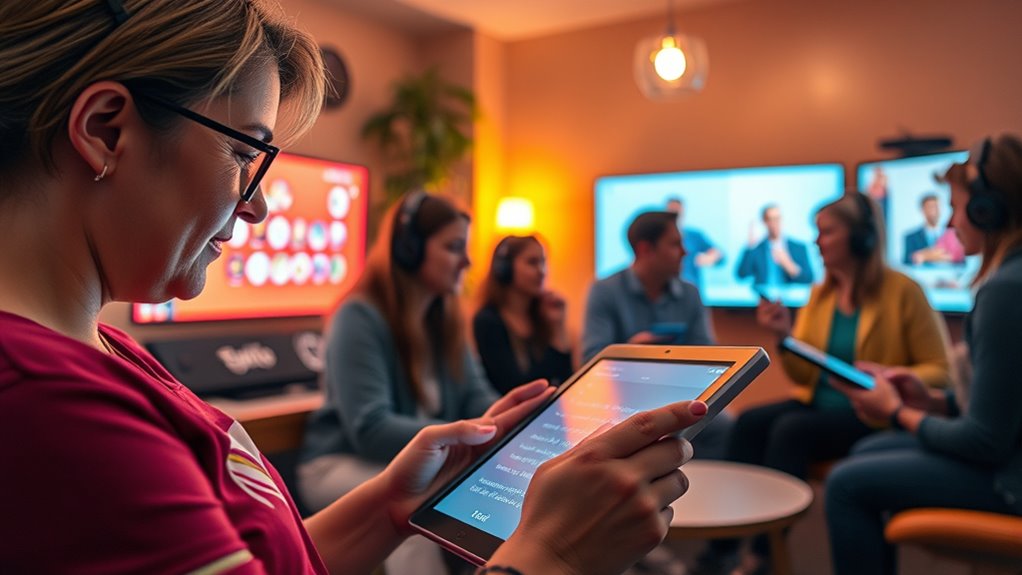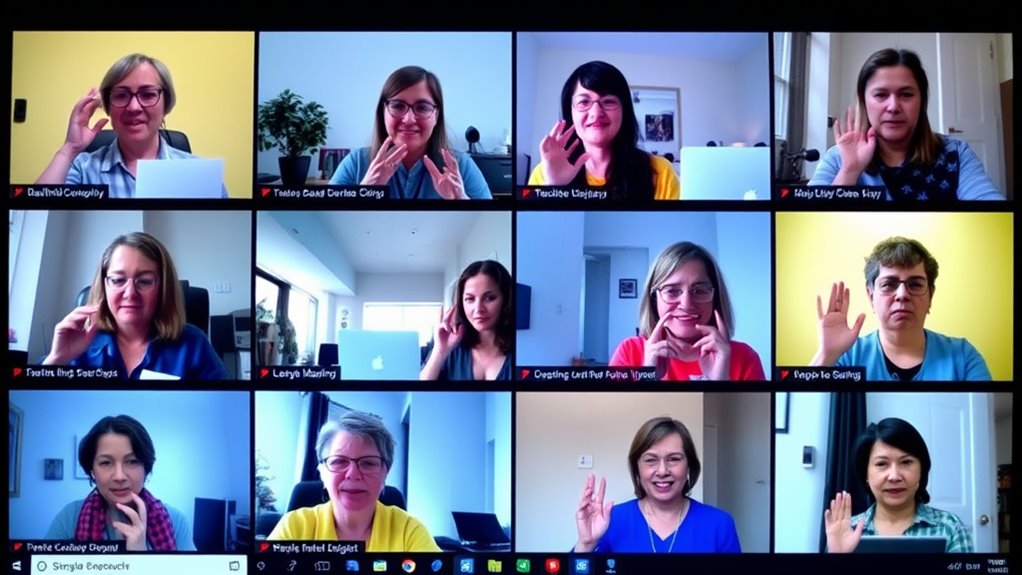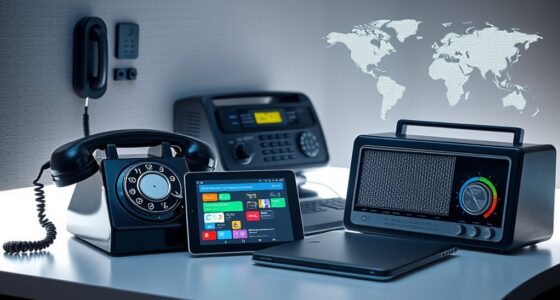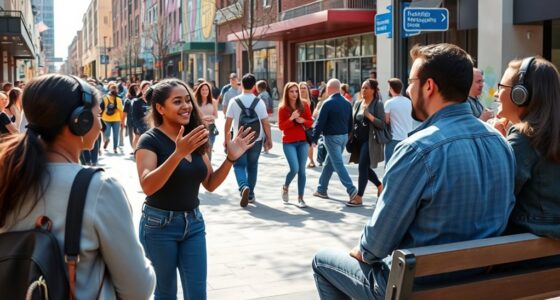In the digital age, you can connect with deafblind communities worldwide using advanced online platforms and assistive technologies. These tools enable real-time communication through tactile feedback, speech-to-text apps, and visual alerts, making support and shared experiences more accessible. Online support groups and social networks foster community, understanding, and resource sharing. As innovations grow, you’ll find even more ways to build meaningful connections and overcome challenges—discover how these digital tools are opening new doors for deafblind engagement.
Key Takeaways
- Digital platforms enable DeafBlind individuals to participate in virtual events, fostering community and shared experiences regardless of location.
- Assistive technologies like tactile feedback, braille displays, and captioning apps enhance communication and independence online.
- Online support networks and forums facilitate emotional bonding, resource sharing, and peer advice within DeafBlind communities.
- Virtual sign language platforms and accessible communication tools promote inclusive conversations and cultural expression.
- Future AI-driven assistive tools and tactile interfaces are expected to further improve digital connectivity and support for DeafBlind users.
The Rise of Digital Platforms for DeafBlind Engagement

Digital platforms have transformed how DeafBlind individuals connect and communicate, breaking down barriers that once limited their interactions. Assistive apps now play a crucial role, offering tools like real-time captioning, tactile feedback, and braille displays that make digital conversations more accessible. Virtual events, such as webinars and social gatherings, provide opportunities to engage without geographic restrictions. You can participate in group discussions, workshops, or support groups from the comfort of your home, fostering a sense of community. These platforms empower you to stay connected, learn new skills, and share experiences with others who understand your challenges. As technology advances, the digital landscape continues to open new doors for DeafBlind engagement, creating inclusive spaces that were once difficult to access. Vetted resources ensure the safety and effectiveness of these tools, further enhancing connectivity and support. A growing array of assistive technology options is making digital communication even more seamless and inclusive. Additionally, digital literacy skills are essential for maximizing the benefits of these platforms and ensuring effective communication. Staying informed about air quality awareness can help DeafBlind users better understand environmental factors affecting their health in various settings. Furthermore, understanding the benefits of eye patches can be useful for those managing eye health or visual comfort in different contexts.
Specialized Communication Technologies Transforming Connections

As technology continues to evolve, specialized communication devices are revolutionizing how DeafBlind individuals connect with others. Assistive app development plays a key role, creating tools that convert text to tactile feedback or produce visual alerts. These apps often incorporate sensory integration techniques, blending auditory, tactile, and visual cues to enhance understanding. For example, haptic feedback devices allow you to feel messages directly through vibrations, while braille displays enable real-time reading of digital content. These innovations break down barriers, making communication more accessible and immediate. By combining advanced hardware with thoughtful software design, these technologies foster deeper connections and independence. Additionally, understanding assistive technology helps in selecting the most suitable devices for individual communication requirements. Furthermore, integrating adaptive communication systems can optimize interaction by customizing features to suit each user’s unique sensory profile.
Online Support Groups and Peer Networks

Online support groups and peer networks use accessible communication tools to connect people facing similar challenges. These platforms foster shared experiences, offering comfort and advice from others who understand what you’re going through. By building community bonds, they create a sense of belonging that can be hard to find elsewhere. Additionally, effective communication tools enable members to engage actively and supportively, strengthening their connections. Exploring virtual collaboration methods can further enhance the way members work together and share ideas. Understanding privacy and cookie policies helps users feel more secure while participating in these online spaces, especially when practicing active listening to promote empathy and understanding. Incorporating inclusive design principles ensures that these platforms remain accessible to individuals with diverse needs, such as those who are DeafBlind.
Accessible Communication Tools
Have you ever wondered how support networks are just a click away for those needing connection? Accessible communication tools make that possible. Assistive apps help bridge communication gaps, offering real-time text relay, speech-to-text, and visual alerts. These tools empower DeafBlind individuals to participate fully in online communities. Virtual sign language platforms enable users to engage through video calls with sign language interpreters or avatars, fostering seamless conversations. Many apps also integrate tactile feedback, ensuring messages are received clearly. These innovations break down barriers, letting you connect with support groups, friends, and mentors anytime, anywhere. By leveraging assistive technology, you can strengthen your sense of community and access essential resources—all from the comfort of your home.
Shared Experience Support
Shared experience support through online support groups and peer networks offers a powerful way to find understanding and encouragement. When you connect with others who share similar challenges, you build emotional resilience and strengthen your cultural identity. These groups provide a safe space to share stories, coping strategies, and victories. Essential oils for emotional well-being can also be incorporated into self-care routines to promote relaxation and stress relief during challenging times. You’ll find that: – Sharing personal experiences fosters empathy and reduces isolation – Peer feedback helps develop emotional resilience during tough times – Celebrating cultural identity reinforces pride and belonging. Additionally, leveraging data-driven strategies can help optimize the support provided, ensuring that resources meet the community’s evolving needs. Recognizing expiration signs like color changes or sediment formation can also help members stay informed about safety and well-being. Understanding cultural significance of tableware can deepen connections and foster pride within the community. Recognizing legal considerations in online communities can further enhance trust and security among members.
Building Community Bonds
Building community bonds through support groups and peer networks creates meaningful connections that foster a sense of belonging. You experience sensory immersion during virtual meetings, which deepens emotional bonding and understanding. These spaces allow you to share challenges and triumphs, strengthening trust and empathy. To illustrate, consider the following:
| Connection Type | Benefit | Experience |
|---|---|---|
| Support Groups | Emotional relief | Sharing stories fosters trust |
| Peer Networks | Skill sharing | Learning from others’ experiences |
| Online Forums | Continuous support | Accessible anytime |
Additionally, understanding diversity in preferences can be an engaging metaphor for exploring diverse perspectives and preferences within the community. Recognizing honey varieties highlights the importance of appreciating different qualities and backgrounds, much like diverse community members. Embracing textile art techniques can inspire creative approaches to community building and expression.
Sharing Resources and Raising Awareness Virtually

Sharing resources and raising awareness virtually can significantly strengthen DeafBlind communities. You can leverage social media, websites, and forums to connect DeafBlind individuals and allies. These tools enable you to share essential resources like sensory integration techniques, accessible technology, and support services directly with those who need them. Additionally, virtual events and webinars expand community outreach, educating a wider audience about DeafBlind experiences. To maximize impact:
- Share success stories to inspire others
- Host live demonstrations of sensory integration methods
- Collaborate with organizations for targeted awareness campaigns
- Promote understanding of skincare patches and their proper use to address skin concerns
Furthermore, employing vertical storage solutions can help organize digital resources efficiently, making information more accessible. Incorporating accessible communication tools ensures that all community members can participate fully in these initiatives. Using digital organization strategies can streamline resource sharing and ensure that vital information reaches those in need. Utilizing secure online platforms is crucial to protect sensitive information and maintain trust within the community. These strategies help foster understanding and support, making resources more accessible and raising awareness about DeafBlind communities’ unique needs. Online platforms create an effective space for collective growth and education.
Overcoming Challenges in the Digital Space

While online platforms offer valuable opportunities for connecting DeafBlind individuals and allies, they also present significant challenges that can hinder effective communication and resource sharing. Sensory adaptation is essential; many must adjust to limited tactile or visual cues, which can slow interactions and cause frustration. Technical barriers, like unreliable internet or incompatible assistive devices, also complicate access. Emotional resilience becomes vital, as repeated setbacks or misunderstandings may lead to frustration or isolation. To overcome these hurdles, you need patience and a proactive mindset, seeking tools and strategies that enhance sensory engagement. Building a supportive online environment requires persistence, adaptability, and strong community bonds, enabling DeafBlind individuals to navigate digital spaces with confidence and continue finding connection and support despite obstacles. Additionally, understanding Yarn for Scarves and other related concepts can foster shared interests and community bonding within online groups.
The Future of Digital Inclusion for DeafBlind Communities

As technology continues to evolve, the future of digital inclusion for DeafBlind communities looks increasingly promising, with innovative tools and platforms designed to bridge communication gaps. Advancements in Assistive Technology will empower users with more intuitive, seamless experiences, making digital spaces more accessible. Policy Development will play a vital role in ensuring equitable access, encouraging wider adoption of inclusive standards, and funding accessible solutions. You can expect:
Advancements in assistive tech and policy will foster a more inclusive digital future for DeafBlind communities.
- Enhanced tactile interfaces that improve real-time communication
- AI-driven tools that translate sign language and Braille into speech or text
- Increased advocacy for policies supporting universal design and digital equity
These developments will help create a more inclusive digital environment where DeafBlind individuals can connect, learn, and thrive without barriers.
Frequently Asked Questions
How Do Deafblind Individuals Access Digital Platforms Effectively?
You can access digital platforms effectively by using accessible technology designed for deafblind users, such as refreshable braille displays and tactile devices. Improving your digital literacy helps you navigate these tools confidently. Many platforms offer features like screen readers and captioning, making content more accessible. Staying updated on new assistive technologies and practicing regularly guarantees you maximize your digital experience and stay connected with communities and resources tailored to your needs.
What Privacy Concerns Exist in Deafblind Online Communities?
You should be aware that privacy concerns in deafblind online communities involve data security risks, like unauthorized access to personal information. Access barriers, such as limited compatibility with assistive technologies, can also compromise your privacy, making it harder to protect your data. To stay safe, use secure platforms, enable privacy settings, and choose technologies that support your needs, ensuring your community stays private and protected.
Are There Global Differences in Digital Support for Deafblind People?
You’ll find that digital support for deafblind people varies globally, influenced by cultural accessibility and linguistic diversity. In some regions, tech tools are tailored to local languages and cultural norms, enhancing inclusivity. However, in others, limited resources or awareness hinder progress. You can see how these differences shape the level of support, making it essential for global efforts to focus on creating culturally accessible and linguistically diverse digital solutions.
How Do Cultural Factors Influence Deafblind Online Engagement?
You might think that culture doesn’t affect online engagement, but it’s the root of many differences. Cultural perceptions shape how deafblind individuals view support and sharing, often creating communication barriers that hinder participation. These perceptions can either open doors or slam them shut. When you understand these nuances, you realize that fostering inclusive digital spaces requires respecting diverse cultural attitudes and overcoming communication hurdles to connect more effectively.
What Training Is Available for Deafblind Users to Navigate New Technologies?
You can access various training programs designed to help deafblind users navigate new technologies. These include specialized communication training that teaches you how to use assistive technology effectively, like braille displays or tactile devices. Many organizations offer workshops, online tutorials, and personalized coaching to boost your confidence. With proper training, you’ll improve your ability to communicate and connect digitally, empowering you to participate fully in online communities.
Conclusion
As you explore the digital world, you’ll discover a gentle bridge connecting deafblind communities, offering warmth, understanding, and shared strength. While some hurdles remain, the increasing presence of supportive platforms and innovative tools paints a hopeful picture. Embrace these virtual connections, knowing they nurture bonds that might have once been difficult to forge. Together, through patience and persistence, you can help create a more inclusive, vibrant space where everyone’s voice can softly and surely be heard.











